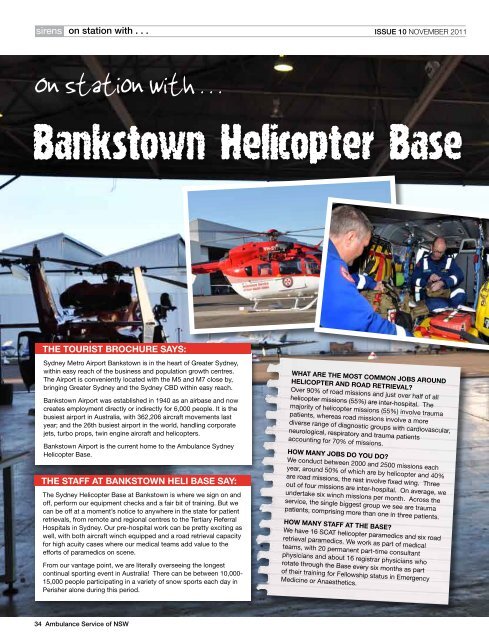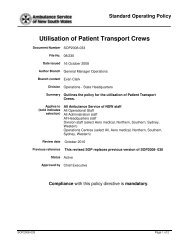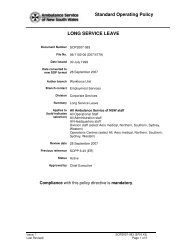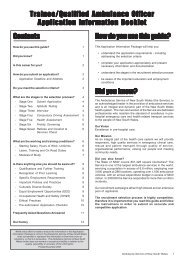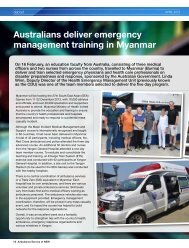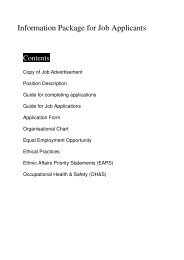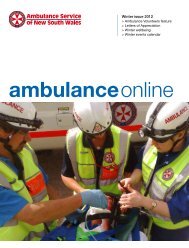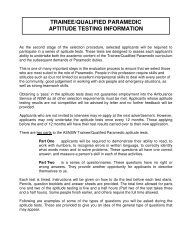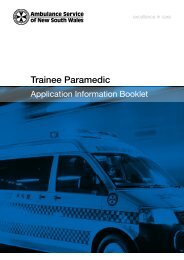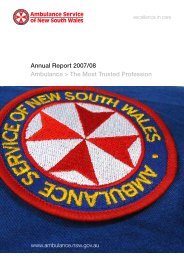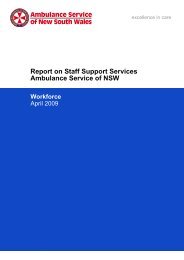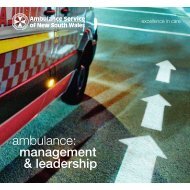Bankstown Helicopter Base - Ambulance Service of NSW
Bankstown Helicopter Base - Ambulance Service of NSW
Bankstown Helicopter Base - Ambulance Service of NSW
You also want an ePaper? Increase the reach of your titles
YUMPU automatically turns print PDFs into web optimized ePapers that Google loves.
sirens on station with . . .issue 10 NOVEMber 2011On station with . . .<strong>Bankstown</strong> <strong>Helicopter</strong> <strong>Base</strong>THE TOURIST BROCHURE SAYS:Sydney Metro Airport <strong>Bankstown</strong> is in the heart <strong>of</strong> Greater Sydney,within easy reach <strong>of</strong> the business and population growth centres.The Airport is conveniently located with the M5 and M7 close by,bringing Greater Sydney and the Sydney CBD within easy reach.<strong>Bankstown</strong> Airport was established in 1940 as an airbase and nowcreates employment directly or indirectly for 6,000 people. It is thebusiest airport in Australia, with 362,206 aircraft movements lastyear; and the 26th busiest airport in the world, handling corporatejets, turbo props, twin engine aircraft and helicopters.<strong>Bankstown</strong> Airport is the current home to the <strong>Ambulance</strong> Sydney<strong>Helicopter</strong> <strong>Base</strong>.THE STAFF AT BANKSTOWN HELI BASE SAY:The Sydney <strong>Helicopter</strong> <strong>Base</strong> at <strong>Bankstown</strong> is where we sign on and<strong>of</strong>f, perform our equipment checks and a fair bit <strong>of</strong> training. But wecan be <strong>of</strong>f at a moment’s notice to anywhere in the state for patientretrievals, from remote and regional centres to the Tertiary ReferralHospitals in Sydney. Our pre-hospital work can be pretty exciting aswell, with both aircraft winch equipped and a road retrieval capacityfor high acuity cases where our medical teams add value to theefforts <strong>of</strong> paramedics on scene.From our vantage point, we are literally overseeing the longestcontinual sporting event in Australia! There can be between 10,000-15,000 people participating in a variety <strong>of</strong> snow sports each day inPerisher alone during this period.What are the most common jobs aroundhelicopter and road retrieval?Over 90% <strong>of</strong> road missions and just over half <strong>of</strong> allhelicopter missions (55%) are inter-hospital. Themajority <strong>of</strong> helicopter missions (55%) involve traumapatients, whereas road missions involve a morediverse range <strong>of</strong> diagnostic groups with cardiovascular,neurological, respiratory and trauma patientsaccounting for 70% <strong>of</strong> missions.How many jobs do you do?We conduct between 2000 and 2500 missions eachyear, around 50% <strong>of</strong> which are by helicopter and 40%are road missions, the rest involve fixed wing. Threeout <strong>of</strong> four missions are inter-hospital. On average, weundertake six winch missions per month. Across theservice, the single biggest group we see are traumapatients, comprising more than one in three patients.How many staff at the <strong>Base</strong>?We have 16 SCAT helicopter paramedics and six roadretrieval paramedics. We work as part <strong>of</strong> medicalteams, with 20 permanent part-time consultantphysicians and about 16 registrar physicians whorotate through the <strong>Base</strong> every six months as part<strong>of</strong> their training for Fellowship status in EmergencyMedicine or Anaesthetics.34 <strong>Ambulance</strong> <strong>Service</strong> <strong>of</strong> <strong>NSW</strong>
issue 10 NOVEMber 2011on station with . . .sirensWhat challenges do you face?The fact that we could end up anywhere in thestate, in any situation for an unknown length <strong>of</strong>time presents a real challenge and attractionto our role. Maintaining the huge range <strong>of</strong> skillsfrom SCAT and retrieval, to winch rescue andnight vision goggles is a challenge requiringconstant training. The fact that we work assingle paramedics with doctors is a greatpr<strong>of</strong>essional development opportunity, as wellas a responsibility. It’s also our role to integrateour doctors safely and effectively into the prehospitalenvironment.What do you enjoy most aboutworking in retrieval?Retrieval is part <strong>of</strong> State Wide <strong>Service</strong>s sowe’re working with a variety <strong>of</strong> people andpersonalities. Being an integral part <strong>of</strong> a highperformance team is really enjoyable andintegrating that team into <strong>Ambulance</strong>’s responseto critical incidents is really satisfying.Of course, sitting in the back <strong>of</strong> a multi milliondollar high-tech helicopter and flying over the top<strong>of</strong> the Opera House and Harbour Bridge downthe helicopter lane is not too shabby either!Why not contact us to have your workplacepr<strong>of</strong>iled? Email Trevor Lee at: sirens@ambulance.nsw.gov.au or call Trevor on 9320 7625.What have been some <strong>of</strong>your most memorablejobs?An MVA in a remote bush settingrecently that involved four elderlymales on a hunting trip and three<strong>Ambulance</strong> Rescue <strong>Helicopter</strong>s.Their open cabin jeep rolled,ejecting all occupants on adown hill stretch, but the animalcarcasses stayed swinging onthe roll bars! The least injuredoccupant crawled to higher groundto raise the alarm. When theRescue 23 arrived, we were ableto land nearby the accident andscramble up the hill to find oneunconscious patient with a headinjury, one patient with abdominalinjuries and a pneumothorax,and one with a fractured femur.Fortunately, we had a local<strong>Ambulance</strong> Supervisor on scene,however in this remote setting andwith the patients separated on thehillside, we were under resourced.The doctor and paramedicperformed a Rapid SequenceInduction to secure theunconscious patient’s airwayand packaged the patient forextrication by stretcher winch.Rescue 26 from Wollongongwinched down their doctor to assistthe paramedic with the remainingpatients, whilst Rescue 23’s doctorwas winched up with the headinjured patient to fly to the nearesttrauma hospital. We treated andpackaged the next two seriouspatients and loaded them into ouraircraft and flew away just in timefor the second Sydney helicopterto arrive and take away the fourthpatient. It’s wonderful to work ina <strong>Service</strong> that has such resourcesavailable for the community.Any staff news going on atthe Sydney <strong>Helicopter</strong> <strong>Base</strong>?It’s raining new staff at the moment.We’ve just received 11 new registrarswho are being trained up for thehelicopter roster and six new roadretrieval paramedics to do highacuity metropolitan retrievals.Dave Zids and his wife recently hadanother baby, Dick Heslewood’sroses are blooming again andMadhura’s got a new car. That allround good guy, Ge<strong>of</strong>f Fudge, hasbeen working with us as bariatriccoordinator and he’s just retired aftermany, many years <strong>of</strong> service.<strong>Ambulance</strong> <strong>Service</strong> <strong>of</strong> <strong>NSW</strong> 35


